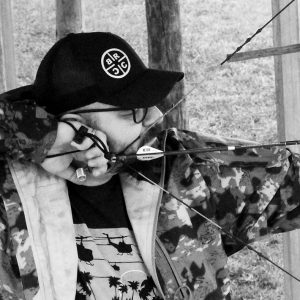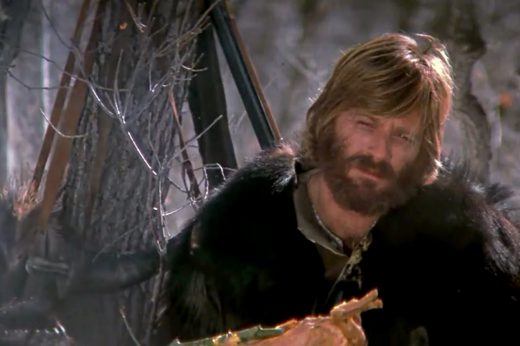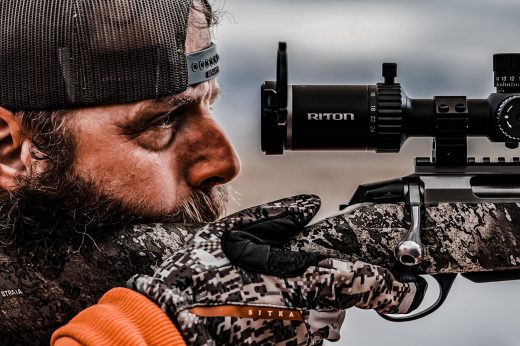Deadwood is arguably the best Western TV show ever produced. It focuses on the early years of a real gold rush boomtown established from a prospecting camp in the Black Hills area of South Dakota in the 1870s. It was a lawless place, loosely organized by gold and the commerce it drew. The town also drew a lot of big personalities, bad characters, and people looking for fresh starts or to make their fortunes in the West.
Naturally, to tell a good deep-dive story about a real town full of real people, a lot of things have to be changed from or added to the sometimes Spartan history of the town’s residents. Let’s take a look at five of Deadwood’s main characters and see how they stack up against their real-life counterparts.
Wild Bill Hickok
Played by: Keith Carradine
In the Show: The legendary, long-haired gunslinger is only in five episodes because, like the real Hickok, he dies in Deadwood.
Carradine plays him as a moody man getting on in years, plagued by alcoholism and by his larger-than-life reputation. The only time he’s even remotely content is when he’s playing poker.
He’s killed by Jack McCall (Garret Dillahunt) who shoots Hickok from behind while he’s playing poker in Nuttall’s No. 10 Saloon. McCall escapes hanging in Deadwood but is later captured by Seth Bullock (Timothy Olyphant) and Hickok’s old friend Charlie Utter (Dayton Callie), who take McCall to Yankton and turn him over to authorities.
In Real Life: James Butler Hickok was indeed shot in the back of the head by Jack McCall in Deadwood on Aug. 1, 1876, while playing poker in the slightly differently named Nuttal & Mann’s Saloon No. 10.
The show correctly depicts the events leading up to the murder — including an insult after a particularly devastating hand of poker — the following trial held in Deadwood with an ad hoc jury, and McCall’s lame-ass defense that he killed Hickok in revenge for his brother’s death at Hickok’s hands in Abilene, Kansas.
After literally slipping the noose in Deadwood, McCall was later arrested by US Marshals (not Bullock and Utter) and was tried again in Yankton, convicted, and promptly hanged.
History Grade: A
Deadwood only had to tell the very end of Hickok’s story, and it got a lot right. The biggest divergence from history was the fledgling friendship depicted between Hickok and Bullock. The real Bullock arrived in Deadwood the day before Hickok was killed, and it’s almost certain the two never met. Other than that, and Hickok carrying his twin Colt Navy revolvers in holsters instead of a sash, the show was pretty spot on.
Al Swearengen
Played by: Ian McShane
In the Show: McShane wonderfully depicts the enigmatic, dangerously charming, shrewd owner of the Gem Saloon as a manipulative whoremaster, drug trafficker, and cold-blooded murderer with a mysterious and storied past. McShane’s Swearengen suffers from kidney stones, as well.
As one of Deadwood’s first residents and the owner of the most lucrative business in town, he’s a sort of small-time mob boss who’s involved in nearly every storyline to some degree, though he hardly ever leaves the confines of the Gem. For many fans, he’s also the most beloved character in the show.
In Real Life: In contrast to the world-wise bachelor and veteran-fucking-cusser who brags of traveling to Australia in the show, the real Swearengen was born the son of farmers in Oskaloosa, Iowa. He lived there well into his adult years before arriving in Deadwood in 1876 with his wife, Nettie Swearengen, who later divorced him. He was married and divorced twice more.
In Deadwood, he opened a canvas-and-lumber saloon called the Cricket, which he later replaced with the Gem Theater: a saloon, dance hall, and brothel. Al was a straight-up pimp who often lured desperate young women to Deadwood with false promises. When they arrived on his dime, he forced them into prostitution. He was also talented at forming alliances and making lucrative financial payoffs, which he could afford because the real Gem brought in an average of $5,000 a night, sometimes $10,000 (that’s $243,000 in 2020 terms).
History Grade: D-minus
Al Swearengen is one of the most fictionalized characters in the show. The real Swearengen was certainly not even a little bit British and was generally way more awful. Even his death is pure fiction. In the Deadwood movie, Swearengen dies in the Gem of cirrhosis. In real life, he was likely murdered. The Gem burned down in 1879 in a fire that claimed much of the town. It was rebuilt and burned down again in 1899. Al split town soon after. In 1904, his body was found with a massive head wound, lying in the middle of a street in a town near Denver.
“Calamity Jane” Cannary
Played by: Robin Weigert
In the Show: Jane Cannary comes to town with Hickok and Utter in the first episode and hangs around for the duration. She’s played as a mumble-mouthed alcoholic with gruff inner goodness and a tendency to have a huge bark without much bite. She absolutely worshipped Hickok and was utterly devastated by his death. She gets involved in a number of storylines as the series progresses, and despite being a rabid drunk, she has a good heart and gets some great lines, such as, “Every day takes figuring out all over again how to fucking live.”
In Real Life: Cannary’s early life is a mix of myths and contradicting stories. She may have been an “Indian Fighter,” but maybe not. She allegedly worked as a scout for Gen. George Custer, or maybe she was a cook. Nobody even knows for sure how she got the nickname “Calamity Jane” or why a woman born Martha Cannary was called Jane, for that matter.
What’s known is that Cannary, noted for wearing men’s clothes and gear, arrived in Deadwood via Rapid City in 1875 and soon fell in with Dora DuFran, the top madam in the area, which may have been the basis for her relationship with Joanie Stubbs in the show. She and Hickok were associated, but the nature of their relationship is unknown — some suggest he greatly disliked her.
Cannary occasionally worked as a prostitute, which is very contradictory to the sexually timid Cannary in the show. She was also one of the first dancers at the Gem Theater and once even took a job rounding up 10 young women in Sidney, Nebraska, for Al Swearengen and bringing them back to the Gem and a fate of banging grody prospectors day and night.
Her alcoholism was also very real, and her drinking and blackouts were a thing of legend even while she was still alive. Later in life, she moved to Montana and performed in Buffalo Bill’s Wild West show and at the 1901 Pan-American Exposition.
As she did in the Deadwood movie, Jane returned to the Black Hills area in the spring of 1903. She worked as a cook for DuFran, who was still an area madam, until July when she jumped on an ore train to Terry, South Dakota. She began drinking heavily on the train, fell ill, and was taken to a hotel where she died soon after. She was buried at Mount Moriah Cemetery, right next to Bill Hickok.
History Grade: C
Deadwood takes certain aspects of Cannary’s life and personality and turns them up to 11. She was known to wear men’s clothes, and the show makes her a closeted lesbian. She was a heavy drinker, so in the show, instances of even mild sobriety are rare. However, Cannary is portrayed as something of a blowhard coward, and it’s doubtful anyone would describe the real Cannary that way — well, at least not the coward part — and from what we know about the woman, her personality was likely a bit different from the slurring, cussing, eternally-caked-in-filth, but truly innocent woman in the show.
Seth Bullock
Played by: Timothy Olyphant
In the Show: Seth Bullock is Swearengen’s foil; he’s a mostly fair and wholesome man who is governed by an unwavering sense of justice, though he is plagued by a fiery temper that sometimes gets the better of him. He’s also damn good with a pistol, as he demonstrates in the first episode, though he rarely draws and even more rarely fires. If the show has a moral compass, he and his friend Sol Star (John Hawkes) are it.
He starts a hardware business with Star, which proves successful, and is later joined by his wife and son in Deadwood. After his brother dies, Seth marries his widow and assumes his familial responsibilities. Tragically, the Bullocks’ son is trampled by a runaway horse. Later, he becomes the town’s hard-nosed sheriff and wears the star well into his later years.
In Real Life: Pretty much everything about Bullock’s arrival in Deadwood went just like it did in the show, including the incident in Helena involving an angry mob and the hanging of a horse thief depicted in the opening scenes of Episode 1, though it went down a bit differently in real life. Things diverge wildly from there, though he did have several real run-ins with Swearengen.
Bullock arrived in town in 1876, and he lived there for the rest of his life. He operated a hardware store with Sol Star at first but made his long-term living from the Bullock Hotel, which was the largest in town and still stands today.
In Helena, he helped create Yellowstone National Park and was elected sheriff of Lewis and Clark County in 1873.
Bullock was sheriff of Deadwood for about 18 months beginning in 1877 but was defeated in the next two elections. He wasn’t a lawman in Deadwood again until 1905, when President Teddy Roosevelt appointed him as a US Marshal. He’d met Roosevelt in 1884, and they’d became lifelong friends. Bullock died of cancer in 1919 in Deadwood and was also buried in Mount Moriah Cemetery.
History Grade: D-plus
While the show gets the beginning of Bullock’s story in Deadwood, and his overall character, spot on, the rest is pure fiction.
He never married his brother’s widow, and his wife, Martha Bullock, and their daughter, Margaret, arrived in Deadwood once he’d established himself there. The family didn’t live in town but on a ranch, and Bullock was not the local sheriff and hardware-store owner for the bulk of his life. Rather, he was a hotelier and served as a lawman in a few different places while living in Deadwood before becoming a Marshal.
E.B. Farnum
Played by: William Sanderson
In the Show: Farnum is a weird dude. He’s a squirrely little man who runs the best hotel in town, which is pretty funky and serves rotten food. He wears old clothes, talks to himself a lot, and never uses five words when he can use 10. He’s annoying, and a few characters take to beating on him at one time or another, but he always survives. Like a cockroach.
Farnum is depicted as a longtime Deadwood resident and a sort of minion of Swearengen. He’s kind of a nervous fuck up, but he’s also deceitful and conniving in his own right, and he’s appointed as a figurehead mayor.
In Real Life: Ethan Bennet Farnum was indeed one of the first few residents of Deadwood and its first mayor, but he actually owned the general store, not a hotel. An extreme bachelor in the show, the real Farnum came to town with his wife, Mary, and they had three children while living there.
Farnum served as the postmaster in Springfield, Wisconsin, before going to South Dakota, where he opened his store in 1876, the same year he was elected mayor. From there, he bought additional properties in town, invested in various mining operations, and was involved in numerous town improvements.
Farnum left town for Chicago in the 1880s and was listed in the 1900 census as a resident of Maury County, Tennessee. The date of his death is unknown.
History Grade: F-plus
The showrunners pretty much made up their version of Farnum out of thin air. Since there isn’t much known about the real Farnum (most early records of the town were lost in the fire that claimed the first Gem), the fictional version can’t exactly be disputed, but what is known about him doesn’t indicate he was anything like the spineless, jerky, jittery weirdo who runs the Deadwood Hotel in the show. But he does get some of the show’s most hilarious lines.
The History Grade of “Cocksucker”
Then there’s this, which gets an A-fucking-plus.
Read Next: The Best Shotgun Moments in Western Movies








Brian Bashynski says
Cocksucker!